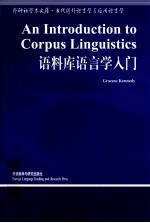

语料库语言学入门PDF电子书下载
- 电子书积分:12 积分如何计算积分?
- 作 者:(新)肯尼迪(Kennedy G.)著
- 出 版 社:北京:外语教学与研究出版社
- 出版年份:2012
- ISBN:7560085296
- 页数:320 页
CHAPTER ONE: Introduction 1
1.1 Corpora 3
1.2 The role of computers in corpus linguistics 5
1.3 The scope of corpus linguistics 7
CHAPTER TWO: The desing and development of corpora 13
2.1 Pre-electronic corpora 13
2.1.1 Biblical and literary 13
2.1.2 Lexicographical 14
2.1.3 Dialect 15
2.1.4 Language education 16
2.1.5 Grammatical 17
2.2 Types of electronic corpora 19
2.3 Major electronic corpora for linguistic research 23
2.3.1 First generation corpora 23
2.3.1.1 The Brown Corpus 23
2.3.1.2 Thee Lancaster-Oslo/Bergen (LOB) Corpus 27
2.3.1.3 Other first generation corpors modelled on the Brown Corpus 29
2.3.1.4 The London-Lund Corpus (LLC) 31
2.3.2 Corpora of English compiled for specialized purposes 33
2.3.2.1 Corpora for lexicography 33
2.3.2.2 Dictionaries as corpora 35
2.3.2.3 Corpora for studying spoken English 36
2.3.2.4 Diachronic corpora 38
2.3.2.5 Corpora for research on language acquisition 40
2.3.2.6 Other corpora for special purposes 43
2.3.3 Second generation mega-corpora 45
2.3.3.1 The Cobuild project 46
2.3.3.2 The Longman Corpus Network 48
2.3.3.3 The British National Corpus (BNC) 50
2.3.3.4 The International Corpus of English (ICE) 54
2.4 Electronic text databases 57
2.5 Issues in corpus design and compilation 60
2.5.1 Static or dynamic 60
2.5.2 Representativeness and balance 62
2.5.3 Size 66
2.6 Compiling a corpus 70
2.6.1 Corpus design 70
2.6.2 Planning a storage system and keeping records 75
2.6.3 Getting permission 76
2.6.4 Text capture 78
2.6.4.1 Written texts 78
2.6.4.2 Spoken texts 80
2.6.5 Markup 82
2.7 Organizations and professional associations concerned with corpus design, development and research 85
CHAPTER THREE: Corpus-based descriptions of English 88
3.1 Lexical description 91
3.1.1 Pre-electronic lexical description for pedagogical purposes 93
3.1.2 Computer corpus-based studies of the lexicon 97
3.1.3 Collocation 108
3.2 Grammatical studies centred on morphemes or words 121
3.2.1 Verb-form use for tense and aspect 122
3.2.2 Modals 130
3.2.3 Voice 134
3.2.4 Verb and particle use 137
3.2.5 Subjunctive 137
3.2.6 Prepositions: of, at, from,between, through, by 139
3.2.7 Conjunctions: since, when, once 144
3.2.8 More andless 152
3.3 Grammatical studies centred on the sentence 154
3.3.1 Sentence length 157
3.3.2 Syntactic processes 159
3.3.2.1 Clause patterning 159
3.3.2.2 Noun modification 162
3.3.2.3 Conditionality 165
3.3.2.4 Causation 167
3.3.2.5 Negation 171
3.3.2.6 Clefting 173
3.4 Pragmatics and spoken discourse 174
3.5 Corpus-based studies of variation in the use of English 180
3.5.1 Comparisons of spoken and written English 182
3.5.2 Comparisons of regional varieties of English 190
3.5.3 Variation in registers and genres 197
3.5.4 Studies of language change 199
CHAPTER FOUR: Corpus analysis 204
4.1 Corpus annotation and processing 206
4.1.1 Lemmatization 206
4.1.2 Word-class tagging 209
4.1.3 Semantic aspects of tagging 225
4.1.4 Parsing 231
4.2 Procedures used in corpus analysis 244
4.2.1 Word lists 245
4.2.2 Concordances 247
4.2.3 Statistics in corpus analysis 258
4.3 Corpus search and retrieval software 259
4.3.1 The Oxford Concordance Program (OCP) 260
4.3.2 WordCruncher 261
4.3.3 TACT 262
4.3.4 Other widely used software for special purposes 263
4.3.5 New generation software 265
CHAPTER FIVE: Implications and applications of corpus-based analysis 268
5.1 Goals of linguistic description and the effect of corpora on methodology 270
5.1.1 Language as possibility and language as probability 270
5.1.2 The description of English 273
5.2 Corpus linguistics and computational linguistics 276
5.3 Corpus-based approaches to language teaching 280
5.3.1 The content of language teaching 282
5.3.2 Language teaching methodology 288
References 295
Index 310
文库索引 316
- 《HTML5从入门到精通 第3版》(中国)明日科技 2019
- 《少儿电子琴入门教程 双色图解版》灌木文化 2019
- 《区块链DAPP开发入门、代码实现、场景应用》李万胜著 2019
- 《Python3从入门到实战》董洪伟 2019
- 《程序逻辑及C语言编程》卢卫中,杨丽芳主编 2019
- 《幼儿园课程资源丛书 幼儿园语言教育资源》周兢编 2015
- 《妈妈365天英语》(韩)申艺莉著 2014
- 《好课是这样创成的 语文卷》雷玲主编 2020
- 《高等学校“十三五”规划教材 C语言程序设计》翟玉峰责任编辑;(中国)李聪,曾志华,江伟 2019
- 《音乐语言的根基》张艺编著 2019
- 《中风偏瘫 脑萎缩 痴呆 最新治疗原则与方法》孙作东著 2004
- 《水面舰艇编队作战运筹分析》谭安胜著 2009
- 《王蒙文集 新版 35 评点《红楼梦》 上》王蒙著 2020
- 《TED说话的力量 世界优秀演讲者的口才秘诀》(坦桑)阿卡什·P.卡里亚著 2019
- 《燕堂夜话》蒋忠和著 2019
- 《经久》静水边著 2019
- 《魔法销售台词》(美)埃尔默·惠勒著 2019
- 《微表情密码》(波)卡西亚·韦佐夫斯基,(波)帕特里克·韦佐夫斯基著 2019
- 《看书琐记与作文秘诀》鲁迅著 2019
- 《酒国》莫言著 2019
